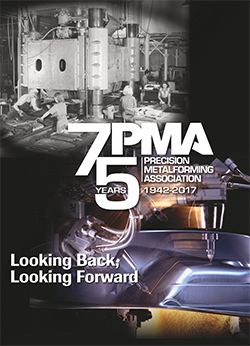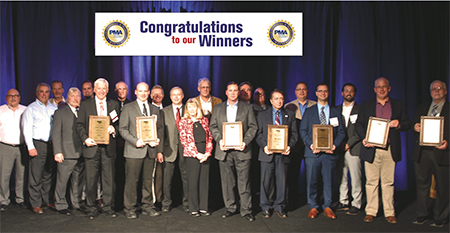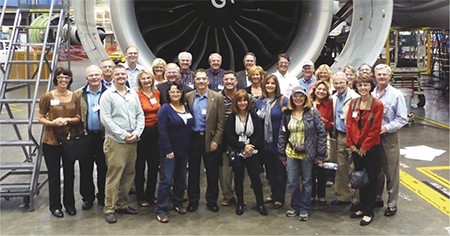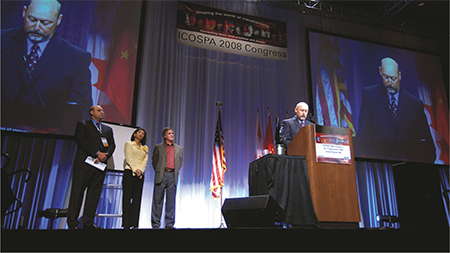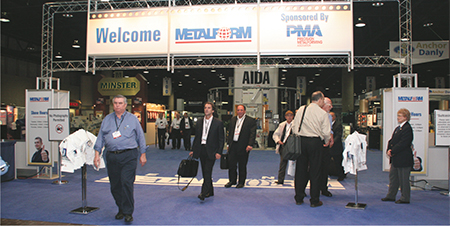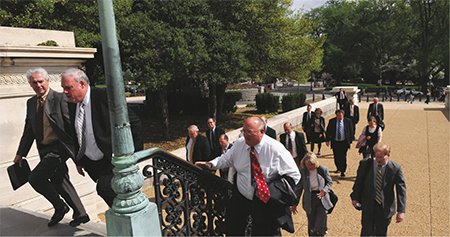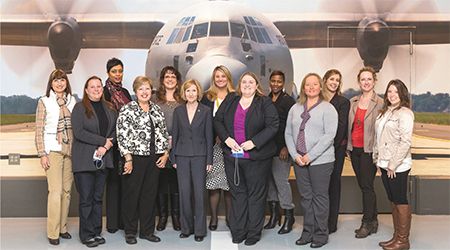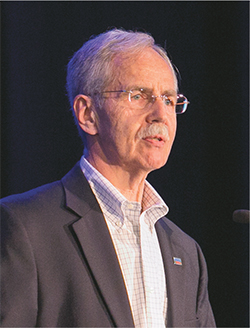March 1967 marked the birth of AMSA’s industry publication, Metal Stamping magazine, which took the name MetalForming in 1988. Over the years, MetalForming has added digital components, including websites, e-newsletters and apps. 3D Metal Printing and Fabricating Product News have since joined the PMA publication roster, and the magazine group also provides webinars and live conferences and events.
|
Gaskin Reflects on 40-Year Association Career As a county economic development director, Bill Gaskin was brand new to the metalforming industry when he joined AMSA in 1977. Thrown into the fire, Gaskin had to learn quickly, and in his 40 years at the association, including the past 17 as PMA president, he’s had a chance to watch PMA, and the role of trade associations, evolve. “Within a short period of time after being hired, I had an incredible opportunity to learn about metalforming, its processes and technologies,” he recalls. “The common link was the flat-rolled metals used by companies, and a forming force that did not rely on heat. Active in government relations and regulations regarding noise and safeguarding, I realized that the government wasn’t fully aware of what our people do. From those experiences it became apparent to me as to how effective a trade association can be. We were effective primarily due to volunteer leaders, willing to spend their own time and money to change things, to be active in committees on technologies and on government and regulatory affairs.” Over his time with AMSA and PMA, Gaskin has seen firsthand how communications have changed the association’s relationship to the industry. “When I joined the staff, we were in a transition from a very face-to-face operation where staff and members needed to travel and be together in local districts,” Gaskin says. “We had 10 to 12 districts then, active groups that met seven or eight times per year, with industry suppliers traveling to district meetings to give presentations. That began to change in the 1980s and into the ’90s as communication and media evolved. “We also met quite a bit with legislators and regulatory officials,” he continues. “Today, we conduct a D.C. fly-in once per year, and we send them numerous e-mails and letters. And, through our lobbying teams, we have a constant presence in Washington and in the ears of our nations’ leaders. We have become a voice for small-business manufacturing, and have had a huge impact on retaining R&D tax credits and lowering tax rates.” Training is another area where PMA flexes its muscle. “We conduct 25 to 30 technical seminars each year,” Gaskin explains. “Attendees receive targeted information on specific topics and the ability to interact with speakers and other participants is very valuable.” The Industry’s Voice “With today’s smart technologies and machines, we as an industry have greater stability, but continual loss of jobs,” Gaskin says. “Manufacturers have the opportunity to take advantage of the technology and become more efficient and compete globally, thus retaining and creating jobs. PMA assists through all of our programs and services. In addition, our leaders in Washington, D.C., must decide to create a climate that allows us to compete with the rest of the world. Through our advocacy and government-relations efforts, PMA is very active in fostering such a climate.” After 40 years, Gaskin gets a well-deserved break owing to his tireless service, and he’s grateful for the opportunity he’s had. He does plan to stay active in the industry by assisting the PMA Educational Foundation in its current capital compaign. “I’ve been blessed to be here,” he concludes. “I’ve been blessed with a phenomenal team, the PMA staff, and an active membership that has given time and money to see our industry succeed.” |
In 1969, AMSA hosted the Third International Technical Conference of Sheet Metal Working, at the Sheraton Hotel in Chicago. This meeting represented AMSA’s first attempt at multilingual, simultaneous translation as well as printing. Each program was presented simultaneously in French, English, German and Japanese. Today, as a member of the International Council of Sheet Metal Presswork Associations (ICOSPA), PMA takes an active role in the ICOSPA Congress, held every three years.
Later, in 1981 at AMSA’s annual Spring Technical Conference in Cleveland, the association organized an exhibition in a hotel parking garage. That event marked the beginning of METALFORM, held every odd year until 1991 when it became an annual affair. In 2009, the METALFORM show became a pavilion in FABTECH as PMA partnered for the first time with other trade associations on that annual event. PMA also now partners on FABTECH Mexico, an annual exhibition and conference.
“PMA hosted the 2008 ICOSPA Congress in Rosemont, IL, in conjunction with our METALFORM show,” Gaskin says. “It was unique because we hosted international visitors for plant tours in Boston, Detroit and Los Angeles, with each location offering a unique blend of plant tours, then we all came together in Chicago. It marks the first time that the ICOSPA Congress was held in multiple locations.”
The 19th ICOSPA Congress will be held in Suzhou, China, this September, with PMA offering a Pre-Congress trip to Shanghai.
Strong Voice Needed in Washington
The Occupational Safety and Health Act of 1970 propelled AMSA to focus intently on safety and generated increased membership as the industry became concerned with the impact of OSHA regulations. The association actively began educating members on OSHA regulations and stepped up its conversations with regulators. Association membership doubled in the early 1970s as a result.
“OSHA made a huge impact in our industry, and led to rapid growth for us,” says Gaskin.
Training in the metal-stamping industry also was emphasized by AMSA in 1971. A series of two-day workshops was held for key employees responsible for their companies’ compliance with the new safety regulations. In conjunction, AMSA compiled its first safety-compliance handbook.
In 1972, AMSA broke ground for a new headquarters’ building in the Cleveland suburb of Richmond Heights, and the association’s technical meeting moved out of the United States for the first time, as more than 900 stampers met in Toronto, Ontario, Canada.
In 1975, Jon Jenson took over as AMSA president, focusing his efforts, and those of the 14-person AMSA staff, on the association’s Metal Stamping magazine, government affairs and industry statistics.
Among the early moves made under Jenson’s direction was the creation, in 1977, of the AMSA political-action committee, primarily to support challengers and congressional races with open seats. The philosophy was to focus on change in order to elect a pro-business and pro-manufacturing Congress. The AMSAPAC became the Precision Metalforming Association Political Action Committee (PMAPAC) in 1987, before becoming PMAVIC (PMA Voice of the Industry Committee) in 1995.
“I was amazed to see how the federal government was impacting our industry,” says Gaskin, referring to his first days on the job in 1977 traveling to Washington, D.C., with the association’s Government Relations committee. “OSHA was a huge issue at the time because it had made the voluntary ANSI B11 machine-safety standards the law of the land. Within five years our membership had increased from 400 to about 800 companies as we tried to educate the industry on the new regulations. Today, the result of the safety standards is a safer industry, so there have been positive impacts of OSHA, but also a lot of costs and regulatory inefficiencies that we have lobbied on.”
PMA’s lobbying efforts took on a particular urgency in the early 2000s.
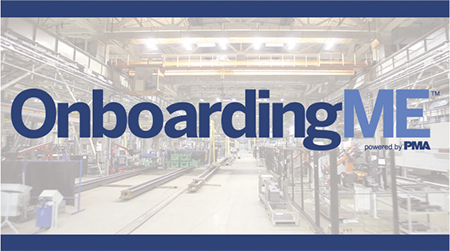 |
| PMA has developed training systems for machine setup and operation, safety, dimensional variation, lockout- tagout, economic literacy, and new-hire orientation, with new web-based training on the way. |
“The 201 steel tariffs were a game changer for our members,” recalls Gaskin. “Steel prices rose overnight and metalformers couldn’t even get materials. PMA was instrumental in forming a coalition that ultimately lowered a 36-month tariff period to 20 months.”
In 2004, recognizing the need to place an even greater emphasis on lobbying, PMA hired full-time lobbyists, and in 2008 joined forces with NTMA to lobby as One Voice for the metalworking industry.
Along with Government Relations and other committees, PMA also operates several industry-specific divisions, including Metal Spinning; Washer Manufacturing; Slideforming; Small-Lot Stamping and Fabrication; Custom Rollforming; Tool and Die; MFG NXT; and, of course, Metal Stamping, the largest of PMA’s divisions.
|
Roy Hardy on the Future of PMA With a pedigree steeped in engineering, manufacturing and our industry’s workpiece metals of choice, Roy Hardy has assumed the leadership position at PMA as its new president, and is tasked with charting its future course. He looks to do that by emphasizing membership engagement, growing membership, promoting advocacy and continuing a commitment to technology transfer and training. A Metals Guy’ 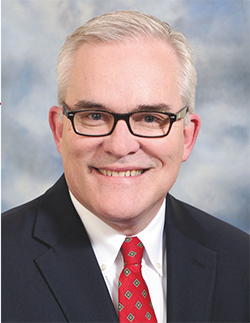
A self-described third-generation metals man—his grandfather worked in a ductile iron foundry for 35 years and his father’s career was spent as a metallurgist at Huntington Alloys—Hardy has had a lifelong fascination with this type of work. “As a kid on plant tours where my dad worked, I watched metal being poured, twisted, bent and recycled to be used again…I’ve always wanted to be a metals guy,” he says. Graduating from the University of Cincinnati with a bachelor’s degree in Metallurgical Engineering, Hardy worked his way through nearly every link of the metal-parts supply chain, then owned a company supplying steel mills, the heattreating industry and forging companies. For the past eight years he has served as president of the Forging Industry Association. Focus on Advocacy, Membership and Training “PMA’s mission is to assist members in being more competitive in the global economy, and I know we can compete if it’s on a level-playing field,” Hardy says, “so we will continue to be active in government advocacy, telling the PMA story.” Recognizing that PMA’s effectiveness as an advocate is directly related to its size and strength, Hardy seeks an increase in membership in coming years and more engaged members. “If we can grow PMA membership to 30 percent of the metalforming industry, we can increase PMA’s clout in Washington, D.C., giving us a bigger voice for the industry. In addition, we need to continue bringing our people together through networking opportunities. Part of that involves empowering and energizing our local districts, the backbone of PMA. Future leaders are found in the districts, and they serve as our first line of communication as to what’s going on, what’s new and what are the concerns.” Key to competitiveness is linking members to the latest, most effective technology, making PMA “a matchmaker for members and technology,” as Hardy says. “We want to expose members to what’s going on related to technology. International conferences and tradeshows are ideal for technology transfer, so PMA will continue to be active in these areas.” To address the industry’s challenge of finding and retaining qualified associates, Hardy stresses the need for workforce-development programs “to develop the talent we already have, and train managers as future company leaders.” And, he sees PMA’s Educational Foundation as instrumental in helping address the skills shortage by raising awareness among the general public, and assisting and funding PMA’s efforts to deliver training via an online learning-management system as well as workshops and seminars. |
Educate, Educate, Educate
Educating the industry always has been a major focus of PMA, and in the 1980s, the association went further by developing training aids using the prevailing media of the day. In 1988, PMA released its first video-based training system to train industry employees setting up and operating manually fed presses, and in 1989 a program was released for training on coil-fed presses. These have been followed over the years by training systems for setting and operating press brakes and metal-spinning machines, as well as a Spanish version of the coil-fed training system, and an updated version (in 1999) of the coil- and manually fed systems. Training systems also have been developed for safety, dimensional variation, lockout-tagout and economic literacy.
The association has followed these efforts with CD-based safety-training aids, and within the past year, PMA debuted Onboarding ME, a DVD orientation program for new employees in metalforming operations. Now, the association has undertaken a major effort to update training offerings via web-based programs.
“Today we are ready to reinvent our video-training programs in a digital age,” explains Gaskin. “The PMA Educational Foundation (PMAEF) will be leading the way over the next couple of years in doing this. We expect to spend $2.5 million to develop new training programs, all digital and delivered over the Internet through a learning-management system. Our industry will be able to take advantage of modern training to build workforce skills, addressing a skill shortage that is as severe as we’ve seen in many years.”
The association has pursued other training initiatives as well. For example, in 1993, PMA began work on creating a skill-standard credentialing system for all of the metalworking industry, which transformed itself into the National Institute for Metalworking Skills (NIMS) in 1995. In 1996, PMAEF was established to support and develop training and education for metalforming skills, and to improve the public image and awareness of careers in metalforming. It raised more than $2 million in an endowment campaign, the majority of which was pledged between 1997 and 2000. Since that time the foundation has made more than $1.5 million in grants to support its mission. Championing a Diverse IndustryRecognizing the growing number of females employed in our industry, from entry-level to management, PMA has sought to provide forums and opportunities for women to network. In 2009, PMA attracted 14 women to its inaugural Women in Metalforming gathering at FABTECH Chicago, IL. In 2011 the group supported the first annual Women in Manufacturing (WiM) event, held in October in Cleveland, which attracted more than 130 women manufacturing leaders who discussed best practices in manufacturing, mentoring, communication strategies and leadership.
“WiM is now an independent 501(c)6 organization with a budget of more than $400,000/year,” says Gaskin. “In 2014, WiM was set up as its own entity, led by PMA Vice President Allison Grealis.”
Now located in Independence, OH, PMA continues promoting and propelling the industry, poised to meet future challenges.
MFWith this article, we’ve sought to recap 75 years of highlights attributed to PMI, AMSA and PMA. In truth, there is so much more. To read more on some of the association’s history, please see the July 2012 issue of MetalForming, which celebrated PMA’s 70th anniversary. It can be accessed at www.metalformingmagazine.com.
View Glossary of Metalforming Terms
See also: Precision Metalforming Association
Technologies: Management, Training
Comments
Must be logged in to post a comment. Sign in or Create an Account
There are no comments posted. Management
ManagementJune 2025 J.D. Power-GlobalData Automotive Forecast
Monday, July 14, 2025
 Management
ManagementSiemens Develops Expedite—Skills for Industry Microcredentia...
Thursday, June 5, 2025
 Management
ManagementTariffs are Not a Strategy: A Call for Action by U.S. Manufa...
Laurie Harbour Tuesday, May 27, 2025







